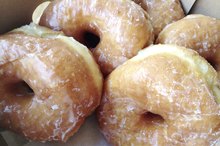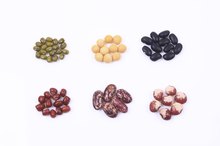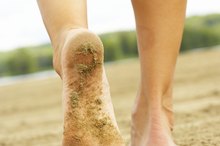What does fact checked mean?
At Healthfully, we strive to deliver objective content that is accurate and up-to-date. Our team periodically reviews articles in order to ensure content quality. The sources cited below consist of evidence from peer-reviewed journals, prominent medical organizations, academic associations, and government data.
- Pubmed Health; Metabolic Syndrome; April 2010
- Pubmed Health; Metabolic Syndrome; April 2010
- MayoClinic.com; The 'Dawn Phenomenon': What Causes It?; November 2009
- Harvard School of Public Health: Carbohydrates: Good Carbs Guide the Way
The information contained on this site is for informational purposes only, and should not be used as a substitute for the advice of a professional health care provider. Please check with the appropriate physician regarding health questions and concerns. Although we strive to deliver accurate and up-to-date information, no guarantee to that effect is made.
Foods to Avoid with an Apple Shape
An apple shape body is characterized by a larger waist circumference, while a pear shape body corresponds to excess fat on the lower body around the hips and thighs. If you have an apple shape, you are at risk of having metabolic syndrome, which is a cluster of high blood pressure, high blood sugar, high triglycerides and low HDL cholesterol caused by insulin resistance -- and all this results from abdominal obesity. To get healthy and prevent diabetes and heart disease, do not eat foods that have high sugar and carbohydrate content.
Breakfast Cereals
Breakfast cereals could be contributing to your large belly. Breakfast cereals, such as:
- puffed rice
- bran flakes
- oat rings
- are all very high glycemic carbohydrates
- even if they don't contain added sugar
- according to the "American Journal of Clinical Nutrition." High glycemic carbs quickly elevate your blood sugar levels and the high insulin levels often seen in people with an apple shape can promote weight gain and increase your risk of blood sugar dysregulation 3
Switch your breakfast to steel-cut oats or quinoa -- or opt for scrambled eggs with vegetables.
Soft Drinks and Fruit Juices
The Carbohydrates in Glazed Doughnuts
Learn More
Soft drinks, fruit juices and other sugary beverages can considerably increase your calorie intake and prevent you from losing weight. Avoid fancy coffees sweetened and flavored with sugary syrups, as well as chocolate milk and energy drinks if you want to lose weight. The high sugar content of these beverages can overwork your pancreas, which has to produce more insulin to compensate for your increasing blood sugar levels, and puts you more at risk of developing type 2 diabetes and other health problems.
Bread, Potato and Pasta
An apple shape body is often associated with insulin resistance, especially if your waist exceeds 40 inches in men or 35 inches in women, according to the National Diabetes Information Clearinghouse. Starchy foods, like breads, potato and pasta, can quickly be broken down into sugar and force your pancreas to secrete insulin to compensate. However, if you are insulin resistant because of the excess weight you carry around the middle, your cells do not respond to normal quantities of insulin and your pancreas will have to produce more. The more insulin resistant you are, the more insulin your body will release. High insulin levels can make you gain more weight and promote chronic diseases, such as heart attacks and diabetes.
- An apple shape body is often associated with insulin resistance, especially if your waist exceeds 40 inches in men or 35 inches in women, according to the National Diabetes Information Clearinghouse.
- Starchy foods, like breads, potato and pasta, can quickly be broken down into sugar and force your pancreas to secrete insulin to compensate.
Desserts
List of Slow & Fast Carbs
Learn More
The key to reducing your apple shape is to reduce insulin levels by not eating too much carbohydrate-rich foods. Weaning yourself off sugar can be difficult at the beginning, but you will soon see big improvements in the way your body looks and how you feel -- and your cravings will gradually disappear.
Related Articles
References
- MayoClinic.com; The 'Dawn Phenomenon': What Causes It?; November 2009
- USDA National Nutrient Database: Nutrient Data Laboratory
- Harvard School of Public Health: Carbohydrates: Good Carbs Guide the Way
- U.S. Centers for Disease Control and Prevention. Insulin resistance and diabetes. Last reviewed August 12, 2019.
- Wilcox G. Insulin and insulin resistance. Clin Biochem Rev. 2005;26(2):19–39.
- Ritchie RH, Zerenturk EJ, Prakoso D, Calkin AC. Lipid metabolism and its implications for type 1 diabetes-associated cardiomyopathy. J Mol Endocrinol. 2017 May;58(4):R225-R240. doi:10.1530/JME-16-0249
- Volpi, E. and Dickinson, J.M. (2015). Protein metabolism in health and diabetes. In International Textbook of Diabetes Mellitus (eds R.A. DeFronzo, E. Ferrannini, P. Zimmet and K.G.M.M. Alberti). doi:10.1002/9781118387658.ch16
- Colorado State University. Pathophysiology of the Endocrine System. Physiologic effects of insulin.
- University of Berkley, California. Endocrine Pancreas.
Writer Bio
Aglaee Jacob is a registered dietitian. She has experience working with people who have diabetes, cardiovascular disease, hypertension and obesity issues. Jacob obtained a bachelor of science and a master of science, both in nutrition, from Laval University in Quebec City, Canada.








